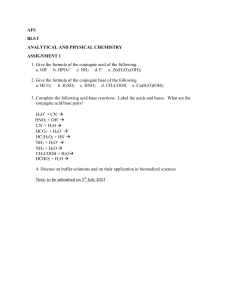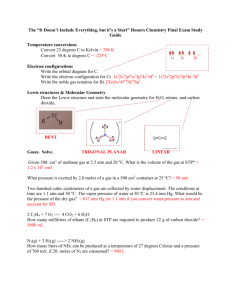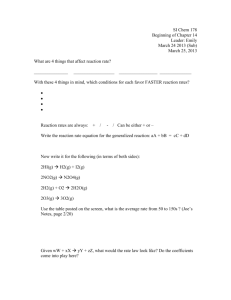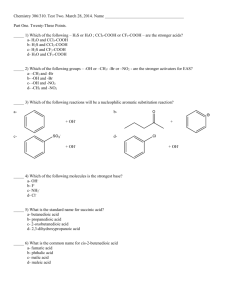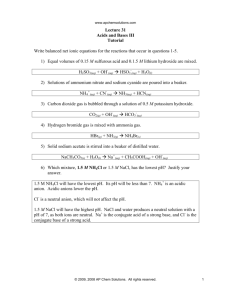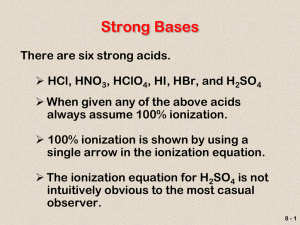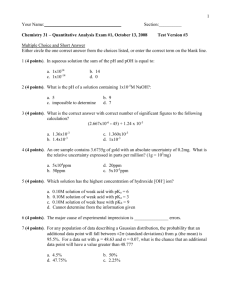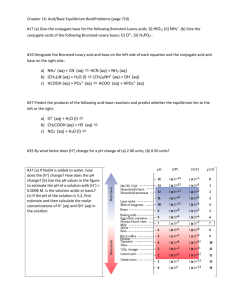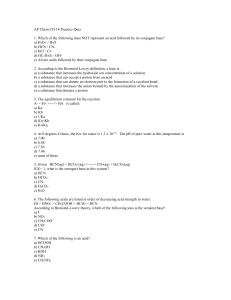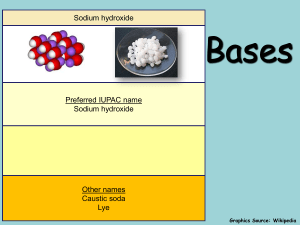Chapter 14 Chemistry Practice Test: Acid-Base Chemistry
advertisement
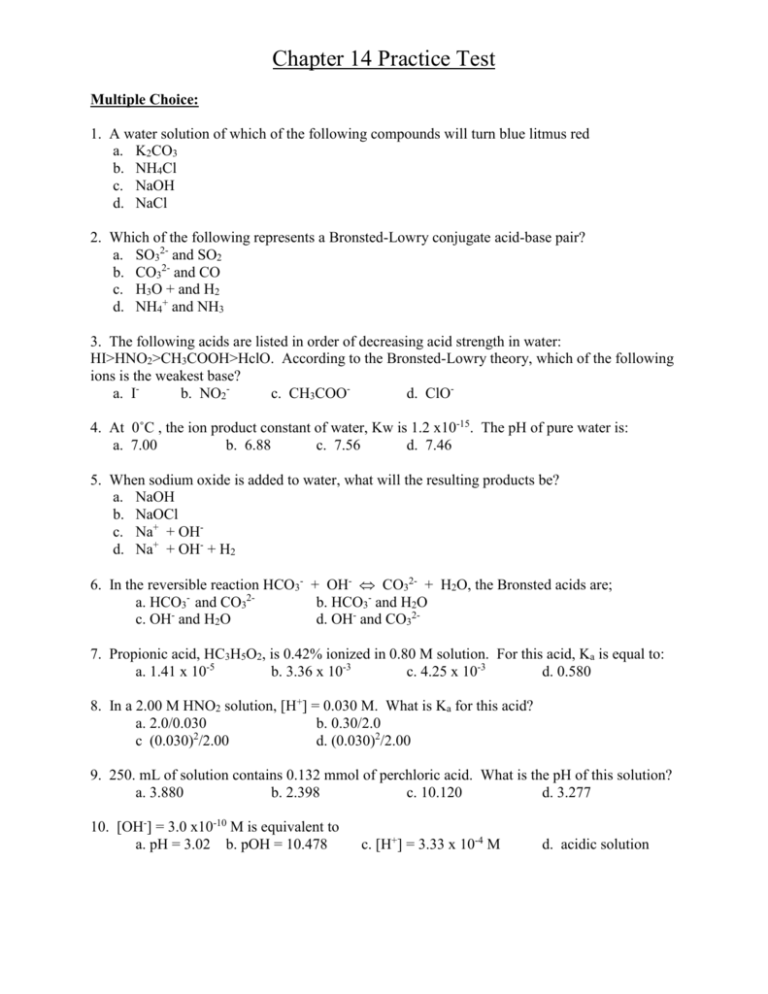
Chapter 14 Practice Test Multiple Choice: 1. A water solution of which of the following compounds will turn blue litmus red a. K2CO3 b. NH4Cl c. NaOH d. NaCl 2. Which of the following represents a Bronsted-Lowry conjugate acid-base pair? a. SO32- and SO2 b. CO32- and CO c. H3O + and H2 d. NH4+ and NH3 3. The following acids are listed in order of decreasing acid strength in water: HI>HNO2>CH3COOH>HclO. According to the Bronsted-Lowry theory, which of the following ions is the weakest base? a. Ib. NO2c. CH3COOd. ClO4. At 0˚C , the ion product constant of water, Kw is 1.2 x10-15. The pH of pure water is: a. 7.00 b. 6.88 c. 7.56 d. 7.46 5. When sodium oxide is added to water, what will the resulting products be? a. NaOH b. NaOCl c. Na+ + OHd. Na+ + OH- + H2 6. In the reversible reaction HCO3- + OH- CO32- + H2O, the Bronsted acids are; a. HCO3- and CO32b. HCO3- and H2O c. OH- and H2O d. OH- and CO327. Propionic acid, HC3H5O2, is 0.42% ionized in 0.80 M solution. For this acid, Ka is equal to: a. 1.41 x 10-5 b. 3.36 x 10-3 c. 4.25 x 10-3 d. 0.580 8. In a 2.00 M HNO2 solution, [H+] = 0.030 M. What is Ka for this acid? a. 2.0/0.030 b. 0.30/2.0 c (0.030)2/2.00 d. (0.030)2/2.00 9. 250. mL of solution contains 0.132 mmol of perchloric acid. What is the pH of this solution? a. 3.880 b. 2.398 c. 10.120 d. 3.277 10. [OH-] = 3.0 x10-10 M is equivalent to a. pH = 3.02 b. pOH = 10.478 c. [H+] = 3.33 x 10-4 M d. acidic solution Chapter 14 Practice Test 11. Which of these is the strongest acid? a. HC2H3O2 b. HC2HF2O2 c. H2O d. HC2H2FO2 12. A 1-molar solution of which of the following salts has the highest pH? a. NaNO3 b. Na2CO3 c. NH4Cl d. NaHSO4 13. Nitrous acid, HNO2, has Ka = 4.5 x 10-4. What is the Kb of the nitrite ion? a. 1.0 x 10-14 b. 4.5 x 1010 c. 3.8.0 x 10-10 d. 2.2 x 10-11 Free Response 1. What is the pH of a 0.150-M solution of hypochlorous acid? What is the percent ionization? 2. Benzoic acid, C6H5COOH, has Ka = 6.3 x 10-5. What is the pH of a solution prepared from dissolving in 3.050 g of benzoic acid in enough water to prepare 0.250 L of solution? 3. What is the pH of a 0.250-M solution of C2H5NH3Cl? 4. What is the pH of a 0.150-M solution of both nitric and nitrous acid? 5. Rank these acids from strongest to weakest? Explain: HBrO3, HBrO2, HBrO. 6. The Ka for propanoic acid, C2H5COOH, is 1.3 x 10-5. a. Calculate the hydrogen ion concentration, [H+], in a 0.20 M solution of propanoic acid. b. Calculate the percentage dissociated of the 0.20 M solution of propanoic acid. 7. 13.5 grams of ammonium nitrate is added to 1.0 L of water. What is the final pH of the solution? The Kb for NH3 is 1.8 x 10-5. 8. Sulfurous acid is a weak diprotic acid with a Ka1 = 1.5 x 10-2 and a Ka2 = 1.0 x 10-7. If you have a 1.0 M solution of sulfurous acid, what are the concentrations of all species? What is the pH of the solution? 9. A solution is prepared by mixing 105 mL of 4.00 M HCl and 48 mL of 6.50 M HNO3. Water is then added until the final volume is 1.00L. Calculate [H+], [OH-], and the pH for this solution. 10. Write out an equation for what happens when the following are added to water. a. HClO3 b. Ca(OH)2 c. SO3 d. BaO e. HPO42f. NH3 g. CH3NH3Cl h. K2S
